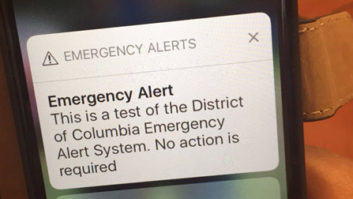Law enforcement advocacy entities such as the National Association of Police Organizations say a National Blue Alert Network would help ensure that information on credible threats is disseminated quickly and widely.

NAPO is among those filing about the notice of proposed rulemaking at the Federal Communications Commission. In June, the FCC released a proposed rule regarding notification of the public through TV and radio of threats to law enforcement officers. The alerts would be used in cases where a law enforcement officer is missing, injured or killed in the line of duty, or when there is an imminent threat to an officer.
NAPO, a coalition of police unions and associations, said it supports the New York-based Blue Alert Act, named after New York City Police Department Officers and NAPO members Rafael Ramos and Wenjian Liu, who were killed while on duty in 2014.
A fully operational National Blue Alert Network would be vital in alerting the public about credible threats, NAPO said. Statistics shared by NAPO tell a chilling tale: 135 officers were killed in the line of duty in 2016. In many of these cases, the individuals posted imminent and credible threats to law enforcement officers on social media. According to NAPO, “a functioning National Blue Alert Network may have prevented some of these unnecessary deaths.”
The organization said the network would allow the federal government to support state and local law enforcement as they work to implement Blue Alert emergency systems at the state level, and also help organize existing Blue Alert systems into a coordinated national framework.
According to NAPO, the lack of a dedicated, national Blue Alert EAS event code is one of the main obstacles to states adopting their own Blue Alert plans.
“With the number of law enforcement officer assaults, injuries, and deaths increasing sharply in recent years, a functioning National Blue Alert Network, with all states participating, is vital for the protection of our nation’s law enforcement officers,” the group said.
NAPO also said a dedicated Blue Alert event code would allow for the promulgation of specific rules to ensure that Blue Alerts are handled in a specific manner by participating media outlets and wireless carriers.
A majority of recent commenters shared similar sentiments.
“The creation of a Blue Alert EAS code is good for law enforcement and the public,” said Michael Zanyor, vice president of the State Troopers Fraternal Association of NJ. “The creation of a Blue Alert EAS code will protect both officers and the public by allowing the quick dissemination of information to facilitate the apprehension of particularly violent and dangerous criminals.”
The assessment was the same for the Police Executive Research Forum: “By alerting the public when officers are attacked, Blue Alerts can help save lives — the lives of other police officers who may be targeted and the lives of residents who are also threatened by these violent criminals. Enhancing the effectiveness of the National Blue Alert Network through a dedicated EAS event code will make all of our communities safer,” the group said. Individuals have weighed in, too. Jeff Olson wrote to the FCC: “As a law enforcement officer I implore the FCC to adopt the Blue Alert system to EAS to help protect myself and my fellow officers.”
There have been voices urging caution though. For instance, as noted in Radio World earlier, some worry about a proliferation in alert types that could cause the public to tune out. “Adding Blue Alerts to the EAS alert table opens the door to more ‘color’ alerts being created until we have added any number of special interest alerts,” wrote Rodney Zeigler, who is a state SECC chair. “[W]hile the idea has good intentions, it sets a bad precedent with many possible unfavorable consequences.”
The public is invited to comment on the proposal through the July 31 deadline. Reply comments on the issue, which is part of PS Docket No. 15-94, are due by Aug. 29.












